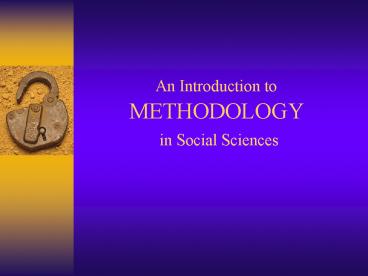An Introduction to METHODOLOGY in Social Sciences - PowerPoint PPT Presentation
1 / 15
Title:
An Introduction to METHODOLOGY in Social Sciences
Description:
The study of methods, it deals with the philosophical assumptions underlying the ... A reflection of your view of an ... Method ology. Analysis. Ontology is. ... – PowerPoint PPT presentation
Number of Views:128
Avg rating:3.0/5.0
Title: An Introduction to METHODOLOGY in Social Sciences
1
An Introduction to METHODOLOGY in Social
Sciences
2
Methodology is
- The study of methods, it deals with the
philosophical assumptions underlying the research
process. - A reflection of your view of an academic problem
- Ontology - An explicit argument for your choice of
theoretical framework - Epistemology
3
Method is
- A specific technique for data collection under
certain philosophical assumptions.
4
Academic Research Problem
Prob Form
Empirical (Method)
Theory
Method ology
Analysis
5
Ontology is..
- A branch of philosophy concerned with the
ultimate nature of existence
6
Epistemology is..
- the branch of philosophy that is directed toward
theories of the sources, nature, and limits of
knowledge. - Includes the method for gathering data and
obtaining knowledge
7
Positivism..
- Realist or determinist cause and effect laws
- Objective observer
- Experimental under carefully controlled
conditions
8
Interpretive/Hermenutic..
- Relativism- knowledge is relative to the
observer - Subjective observer
- Hermeneutic/interpretivism - data consists of
description
9
Positivist vs. Interpretive
- Positivist
- examining exterior data, what and when changes
occur - viewing societal trends and changes limited in
its perceptions and can best be used for
determining when and to what extent groups in the
society interact - Interpretivist/Hermenutic
- examining interior, how and why changes occur
- allows for communication with the cultural
background of a situation
10
Qualitative vs. Quantitative
- Quantitative methods are associated with
empirical, positivist research - Statistical analysis, describing pop. samples
- Qualitative research is associated with
anti-positivist philosophies, such as
interpretivism, ethnography, etc. - Textual records
11
Positivist Time parents are in church
compared to of child brides Hypothesis
higher of girl-children become child brides if
their parents were more active in the religion
Empirical Data Survey conducted, data gathered
and tested against hypothesisConclusion data
confirmed hypothesis, therefore the more active
the parents, the more likely that the child would
participate in the ritual.
Positivist vs. InterpretiveMormon Child Brides
12
Positivist vs. InterpretiveMormon Child Brides
- Interpretive Approach
- Examine why the girl-child was considered
suitable to be a bride and what the union meant
to the participants - Empirical Data Qualitative Interviews
- Conclusion would be that the unions were carried
out under the guise of being blessed by God in
their after life and acted as a right of passage
for a girl-child.
13
The Fundamental Method
- All research depends upon observation
- Observation may be direct
- Researcher as observer, collecting data,
recording info (primary sources) - Observation may be indirect
- Researcher must rely on reported observations,
(secondary sources)
14
Choice of Method
- Researcher must choose a philosophical approach
(ex. positivistic or interpretative) within which
to work, and must then determine which method is
most appropriate for the kind of data they wish
to collect
15
Methodology Section must include..
- An explicit argument for your choice of theory
- An explanation of your Empirical Data
- Ex. Secondary sources
- Electronic Resources
- Statistical data
- Ex. Primary resources (collection)
- Questionnaires
- Surveys




























![[PDF]❤️DOWNLOAD⚡️ Multilevel Analysis for Applied Research: It's Just Regression! (Methodology i PowerPoint PPT Presentation](https://s3.amazonaws.com/images.powershow.com/10047869.th0.jpg?_=20240605039)

![[PDF]❤️DOWNLOAD⚡️ Multilevel Analysis for Applied Research: It's Just Regression! (Methodology i PowerPoint PPT Presentation](https://s3.amazonaws.com/images.powershow.com/10048515.th0.jpg?_=202406051111)
